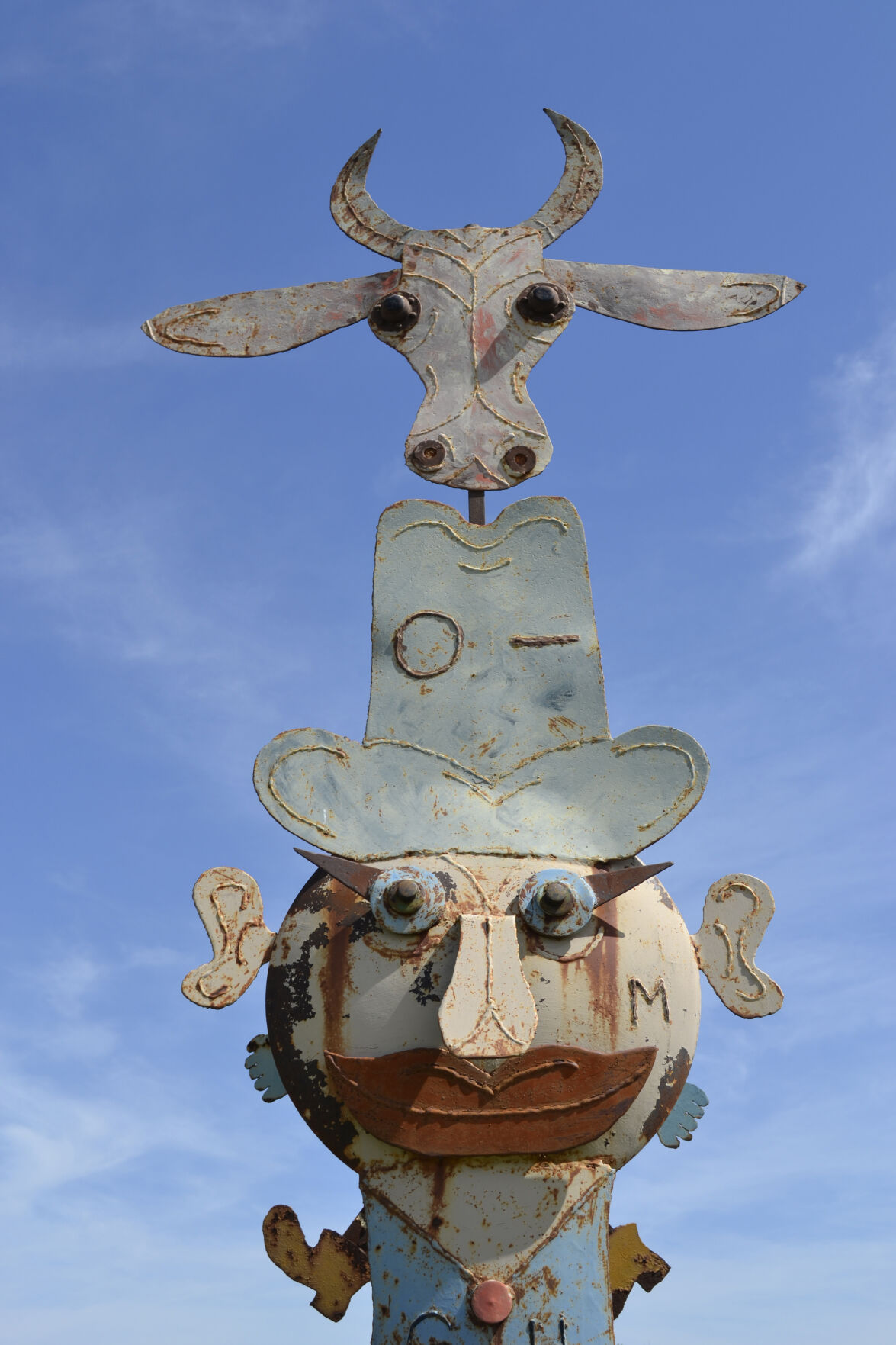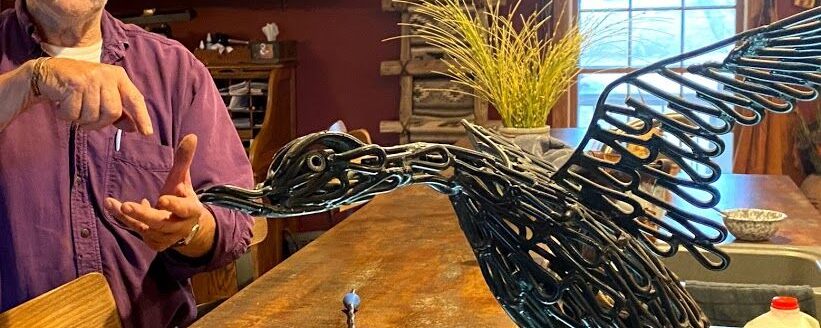What some people consider scraps for the trash bin, grassroots artists see as material for kinetic sculptures, lawn ornaments, mosaics and other creations. These self-taught artists recycle and repurpose items like farm machinery parts, broken pottery, wood, fiberglass and other nontraditional art materials to create something new and express their perspective.
Lucas, Kansas, has a population of less than 400, but the tiny rural community in the north-central part of the state attracts visitors from all over the world as home to the Garden of Eden and other art attractions like Bowl Plaza, the town’s mosaic-covered public restroom.
Samuel P. Dinsmoor, a Civil War veteran, retired teacher and farmer, began building the Garden of Eden’s cabin and sculptures from concrete and limestone in 1907 at age 64. The creations reflect Dinsmoor’s religious views and his support for the Populist movement of that time.
Next to the Garden of Eden are Roy and Clara Miller’s miniature buildings, which they built from rocks and shells they collected during their travels to Colorado. Nearby stands Florence Deeble’s rock garden, featuring concrete and rock postcard scenes of her favorite places as well as local history.
“Especially with environment makers, it’s not something that just hangs on a wall by itself. You get immersed in this whole environment, so when you’re at these sites, you end up stepping into somebody’s biography,” said Lucas-based visionary artist and educator Erika Nelson.
Lucas’ immersive art environments and support for grassroots artists led former Gov. Bill Graves to designate Lucas as the “Grassroots Art Capital of Kansas” in 1996. The Grassroots Art Center downtown preserves other examples of grassroots art and the stories of the past and present artists who create it.
Executive Director Rosslyn Schultz helped establish the art center in the 1990s.
She said grassroots artists generally have several characteristics in common:
• They do not have a terminal degree in art;
• They have considerable time to dedicate to their artistic pursuits and are often retired;
• They use recycled materials or other nontraditional media; and
• They have a strong drive to create.
“They’re all just so in tune with what they’re doing and truly love that sheer joy of creating something, and you can sense that the moment you meet them,” Schultz said.
She and her husband, Steve, have met many grassroots artists as they have traveled the country collecting and curating art for the center, whether it’s a set of miniatures or an enormous sculpture that has to be towed to Lucas in a trailer.
“There’s always little gems along the way,” she said, noting that they have found many grassroots art pieces throughout the United States via word of mouth, sometimes where they least expect them.
Flying Free
The Grassroots Art Center is celebrating its 25th anniversary through Oct. 31 with an exhibition, “Flying Free: 25 Years of Grassroots Art.” Schultz said the retrospective showcases the work of 121 artists, including an art piece or photograph from 19 grassroots artists based outside of Kansas.
She enjoys sharing not just the art but also the artists’ stories with visitors of the Grassroots Art Center. A commemorative catalog of Flying Free artists documents the artists’ work. “It’s been quite a journey to put these together, and I feel like we’ve really accomplished something,” Schultz said.
Sign up for HPJ Insights
Our weekly newsletter delivers the latest news straight to your inbox including breaking news, our exclusive columns and much more.
Ruby Meyer discovered her love for papier-mâché when she made a Hereford sculpture as a prop for one of her children’s 4-H talks. Her daughter, Melissa Nelson, continued the tradition following Meyer’s death. Their papier-mâché circus menagerie is featured in the Flying Free exhibition.
Schultz explained that fiber artist Elizabeth Jeannette Burch, Roxbury, Kansas, didn’t simply throw away fabric remnants and other scraps of material. Instead, she used them to add texture to her scenes of farms and rural landscapes.
Raymond “Fox” Still, a former police chief in Sharon Springs, Kansas, made archery targets in the shape of various animals and other creatures, real or imaginary, out of Styrofoam, pipes and wood to practice bow hunting. Ten of his targets now reside in Lucas, including a saber-toothed tiger on Main Street. Schultz said a local artist, Lacie Shirley, is working to restore the other creatures.
Whimsical whirligigs
Visitors can see examples of Myron Thomas “M.T.” Liggett’s welded scrap metal totems and whirligigs on display at the Grassroots Art Center, but they would need to travel to Mullinville to fully appreciate the scope of his work along the fencelines of U.S. Highway 400 and Kansas Highway 54. Erika Nelson said it’s important to preserve these outdoor works of art and to see them in context.
Although not technically considered a grassroots artist because she has a master’s degree in fine arts from the University of Kansas, Nelson is an active caretaker of grassroots art. She is involved in restoration and preservation work at the Garden of Eden and is currently helping to preserve Liggett’s Mullinville art environment.
Maintenance of the more than 600 totems is important, and the weather causes wear and tear to outdoor environments just as it does to vehicles. Part of Nelson’s work involves developing a maintenance schedule akin to a vehicle owner’s manual to keep the kinetic sculptures moving in the southwest Kansas wind.
“It’s like having a car,” Nelson said. “Since M.T.’s work has so many moving parts, those have to be serviced.”
Following Liggett’s death in 2017, the Kohler Foundation partnered with the M.T. Liggett Trust to preserve the totems. A visitor’s center is under construction on the site where Liggett’s studio was located. “There are interpretive displays that have been written and photographs gathered, and they’re in the building process with that now,” Nelson said.
She explained the team is also collecting oral histories from local residents so that visitors can learn more about Liggett’s life as they view his rural art. “M.T. was so much a part of Mullinville and that region. They’ve made it a point to make sure that’s part of the story too—that you’re not just getting the art view or M.T.’s view but you’re also getting the neighbors’ view,” she said.
“What was it like to grow up here or be a neighbor of M.T. and suddenly find yourself on a totem on a fence where you can’t ignore it?”
Because Liggett boldly expressed his beliefs about politics, people and current events in his totems and signs, often excoriating political figures and even neighbors in his work, his art caused controversy. Nelson said she hopes the efforts to preserve his legacy stay true to who Liggett was and portray how complex he was as an artist so visitors get a full picture of him, not just a sanitized version.
“I think, especially after a maker dies, it’s really easy to sort of censor or rewrite the history,” she noted. But she hopes the preservation effort “remains as true to what he intended, and how he was, as it can.”
“Some of the raunchy stuff should still be out there,” Nelson said. “Some of the stuff that really makes people mad should still be out there.”
According to the 5.4.7 Arts Center in Greensburg, which will manage the M.T. Liggett Art Environment, the visitor center is expected to open by the end of summer 2021.
Grassroots art field trips
Schultz said as part of the 25-year anniversary celebration, the Grassroots Art Center will host several field trips this year to see grassroots art environments in Kansas. The June 24 trip to Wichita will feature work by Gary Pendergrass and Dan Beck with Chris Poelma. A July 24 field trip to Great Bend and Sylvia will tour work by Bob Mix and Don Brownlee with Michael Murphy. The Sept. 14 tour in Hays highlights the work of Curly Leiker, Pete Felten and Bruce Burkholder. To reserve a spot on a field trip, call the Grassroots Art Center at 785-525-6118. Learn more about the artists at https://www.grassrootsart.net/25yearexhibit.
Schultz encourages people to help the Grassroots Art Center scout for more artists to showcase in future exhibits—and you never know where you may find them. “Everybody goes down different roads and on different journeys,” she said.
Shauna Rumbaugh can be reached at 620-227-1805 or [email protected].




